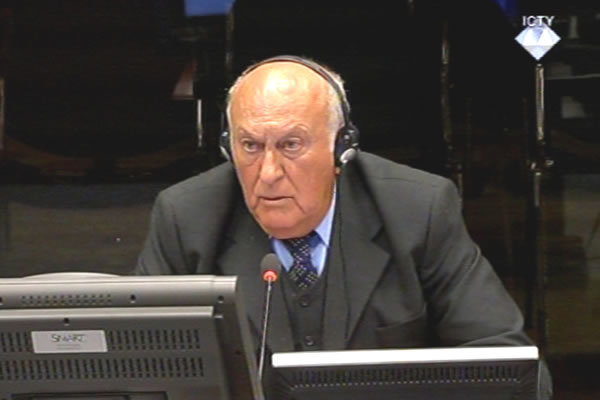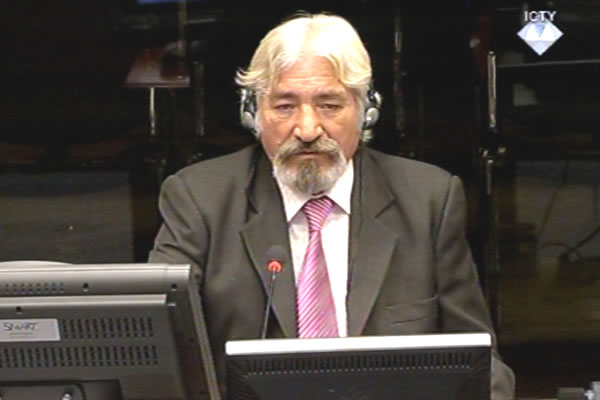Home
NOBODY EXPELLED MUSLIMS AND THEY SHELLED THEMSELVES
At the trial of Radovan Karadzic, Milivoje Kicanovic from Bijeljina claimed that Muslims left the town because they wanted to. The local Serbs helped them to reach the separation lines. Some Serbs felt they deserved a Nobel Prize for their efforts. VRS Lieutenant colonel Desimir Sarenac said that the citizens of Sarajevo shelled themselves, either deliberately or accidentally
 Milivoje Kicanovic, defence witness of Radovan Karadzic
Milivoje Kicanovic, defence witness of Radovan Karadzic ‘The Muslims started’ the conflict in Bijeljina on 31 March 1992, when they ‘set up road blocks and opened fire on Serbs; Serbs didn’t return the fire’, said Milivoje Kicanovic, member of the SDS Municipal Board in Bijeljina and former hospital director.
In his evidence in the defense of Radovan Karadzic, Kicanovic insisted that Muslims weren’t expelled from Bijeljina. They left the town because they wanted to; Vojkan Djurkovic only ‘helped’ them to reach the separation line. During the prosecution’s case , the judges watched a BBC report from Bijeljina in which Djurkovic says he sees himself as a ‘social worker’, and wants to get a Nobel Prize for his efforts.
Prosecution witness Milorad Davidovic, former inspector in the Yugoslav Federal SUP, described Djurkovic’s ‘social work’ as ‘mass expulsion of undesirable citizens’ who were first robbed and then taken in trucks to the separation line.
Karadzic’s next witness, VRS lieutenant colonel Desimir Sarenac claimed that the citizens of Sarajevo shelled themselves, both accidentally and deliberately. They made make-shift projectiles that would often ‘fall short’ and hit residential areas under the BH Army control instead of the Serb positions that were the original targets. Sarenac mentioned the massacres in the bread queue in Vase Miskina Street and the Markale town market as examples of purported ‘self-shelling’.
Sarenac contends that the shells fired from the VRS positions on Sarajevo had ‘no effect’. The shells could only shatter the roof tiles or, if the worst came to the worst, a 120-mm shell could penetrate through to the ceilings. According to the witness, the buildings were so densely situated in that area that it was impossible or very unlikely that shells would hit a street or an open space. Serb forces didn’t have laser guidance equipment, the witness said.
Sarenac spent the whole war in the Sarajevo theatre of war as the chief of security in the 1st Sarajevo Brigade. From May to October 1995, Sarenac was the commander of the 4th Battalion in the 1st Sarajevo Brigade. Through Sarenac, Karadzic tendered into evidence maps of Sarajevo with the witness’s marks indicating the locations of the front lines, areas of responsibility of his brigade and the BH Army 10th Mountain Brigade, and the locations of the BH Army’s arms factories, commands, headquarters and other facilities.
In the cross-examination, prosecutor Carolyn Edgerton contested the reliability of the marks the witness had put on the maps. She said that Sarenac’s marks would indicate that the part of Dobrinja where the football pitch shelling incident occurred in June 1995 was under the VRS control. That was not true. The witness agreed that he didn’t know exactly where the buildings he marked on the maps were located. Over the past 20 years, he ‘forgot a lot of it’, the witness explained. Nevertheless, Sarenac remained adamant that the military and police forces were stationed in the facilities he marked on the maps.
Desimir Sarenac’s cross-examination continues tomorrow.
Photos
Linked Reports
- Case : Karadzic
- 2013-03-05 WITNESS HEARD A LOT, KNEW LITTLE
- 2013-03-04 NEUTRAL BUT ON SERB SIDE
- 2013-03-01 DIFFERENCES BETWEEN RECEPTION CENTER AND PRISON
- 2013-03-07 WERE SHELLS BROUGHT BY STORKS?
- 2013-03-07 ‘POLICE SHOULD NOT INTERFERE’
- 2013-03-11 VERIFYING ‘RUMORS’ ABOUT CONDITIONS IN PRISON CAMPS

